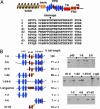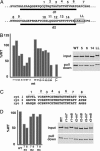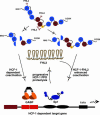Site-specific proteolysis of the transcriptional coactivator HCF-1 can regulate its interaction with protein cofactors
- PMID: 16624878
- PMCID: PMC1440766
- DOI: 10.1073/pnas.0602109103
Site-specific proteolysis of the transcriptional coactivator HCF-1 can regulate its interaction with protein cofactors
Abstract
Limited proteolytic processing is an important transcriptional regulatory mechanism. In various contexts, proteolysis controls the cytoplasmic-to-nuclear transport of important transcription factors or removes domains to produce factors with altered activities. The transcriptional coactivator host cell factor-1 (HCF-1) is proteolytically processed within a unique domain consisting of 20-aa reiterations. Site-specific cleavage within one or more repeats generates a family of amino- and carboxyl-terminal subunits that remain tightly associated. However, the consequences of HCF-1 processing have been undefined. In this study, it was determined that the HCF-1-processing domain interacts with several proteins including the transcriptional coactivator/corepressor four-and-a-half LIM domain-2 (FHL2). Analysis of this interaction has uncovered specificity with both sequence and context determinants within the reiterations of this processing domain. In cells, FHL2 interacts exclusively with the nonprocessed coactivator and costimulates transcription of an HCF-1-dependent target gene. The functional interaction of HCF-1 with FHL2 supports a model in which site-specific proteolysis regulates the interaction of HCF-1 with protein partners and thus can modulate the activity of this coactivator. This paradigm expands the biological significance of limited proteolytic processing as a regulatory mechanism in gene transcription.
Conflict of interest statement
Conflict of interest statement: No conflicts declared.
Figures





Similar articles
-
Transcriptional coactivator HCF-1 couples the histone chaperone Asf1b to HSV-1 DNA replication components.Proc Natl Acad Sci U S A. 2010 Feb 9;107(6):2461-6. doi: 10.1073/pnas.0911128107. Epub 2010 Jan 21. Proc Natl Acad Sci U S A. 2010. PMID: 20133788 Free PMC article.
-
Autocatalytic proteolysis of the transcription factor-coactivator C1 (HCF): a potential role for proteolytic regulation of coactivator function.Proc Natl Acad Sci U S A. 2000 Aug 15;97(17):9425-30. doi: 10.1073/pnas.160266697. Proc Natl Acad Sci U S A. 2000. PMID: 10920196 Free PMC article.
-
Combinatorial transcription of herpes simplex virus and varicella zoster virus immediate early genes is strictly determined by the cellular coactivator HCF-1.J Biol Chem. 2005 Jan 14;280(2):1369-75. doi: 10.1074/jbc.M410178200. Epub 2004 Nov 1. J Biol Chem. 2005. PMID: 15522876
-
The multifunctional roles of the four-and-a-half-LIM only protein FHL2.Cell Mol Life Sci. 2006 Feb;63(3):268-84. doi: 10.1007/s00018-005-5438-z. Cell Mol Life Sci. 2006. PMID: 16389449 Free PMC article. Review.
-
The biological relevance of FHL2 in tumour cells and its role as a putative cancer target.Anticancer Res. 2007 Jan-Feb;27(1A):55-61. Anticancer Res. 2007. PMID: 17352216 Review.
Cited by
-
Association of the cellular coactivator HCF-1 with the Golgi apparatus in sensory neurons.J Virol. 2008 Oct;82(19):9555-63. doi: 10.1128/JVI.01174-08. Epub 2008 Jul 30. J Virol. 2008. PMID: 18667495 Free PMC article.
-
O-glycosylation in viruses: A sweet tango.mLife. 2024 Mar 25;3(1):57-73. doi: 10.1002/mlf2.12105. eCollection 2024 Mar. mLife. 2024. PMID: 38827513 Free PMC article. Review.
-
Transcriptional coactivator HCF-1 couples the histone chaperone Asf1b to HSV-1 DNA replication components.Proc Natl Acad Sci U S A. 2010 Feb 9;107(6):2461-6. doi: 10.1073/pnas.0911128107. Epub 2010 Jan 21. Proc Natl Acad Sci U S A. 2010. PMID: 20133788 Free PMC article.
-
The dynamics of HCF-1 modulation of herpes simplex virus chromatin during initiation of infection.Viruses. 2013 May 22;5(5):1272-91. doi: 10.3390/v5051272. Viruses. 2013. PMID: 23698399 Free PMC article. Review.
-
Crosstalk between O-GlcNAcylation and proteolytic cleavage regulates the host cell factor-1 maturation pathway.Proc Natl Acad Sci U S A. 2011 Feb 15;108(7):2747-52. doi: 10.1073/pnas.1013822108. Epub 2011 Feb 1. Proc Natl Acad Sci U S A. 2011. PMID: 21285374 Free PMC article.
References
Publication types
MeSH terms
Substances
Grants and funding
LinkOut - more resources
Full Text Sources
Molecular Biology Databases

